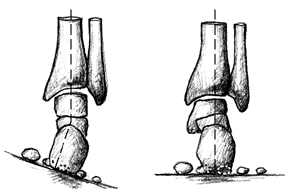What’s your Foot Type?: Part 1
Ready for Monday Morning? This is the 1st of a 5 part series to get your week going and help get you in a “Gait Guys” frame of mind
Rearfoot varus
What if many of your nagging and seemingly un resolvable injuries as an athlete were from an undiagnosed foot type? What if every shoe, insert and orthotic you implemented in an attempt to help manage these problems was not the solution, but rather a means of “band aiding” the problem because your anatomy was compromised from the start?
Wouldn’t it be nice to have some answers to all the questions you have as to why your interventions were less than optimal? Wouldn’t life be better if you knew that your anatomy was slightly left of center and that this was the true cause? Life as an athlete sure would be more tolerable and perhaps, just perhaps, a life with fewer nagging injuries.
The main issue is that the majority of humans have less than perfect feet. The “perfect” neutral foot is one in which the rearfoot and the forefoot lie on the same plane, meaning that the forefoot and the rearfoot lie square on the ground when ankle and subtalar joint mechanics are neutral. This insures the tripod of the foot (the base of the big toe, the base of the little toe and the center of the heel) remain on equal footing, creating a balance of power between the muscles and articulations.
There are many reasons at to why we do not all have perfect feet with pristine mechanics to run and walk on. Some are genetic, some congenital, and some developmental. Regardless, as the saying goes “You have what you have, so why not make the best of it?”
In a nutshell, there are 5 basic foot types; two involving challenges to the forefoot, and two challenging the rear foot. These can be rigid and non adapting, flexible and adapting, or somewhere in between. The fifth type is the ideal of what we all hope to have. This 5 part series will help you to understand each and the biomechanics associated with the anatomical variant.
Rearfoot varus.
The rear foot varus is a foot that has the heel inverted, almost appearing as though the ankle is about to roll, like a common ankle sprain. Here the rear of the tripod is compromised. Because of this lateral shift of weight through the contact phase of walking or running, the foot is over supinated (plantar flexed, inverted and adducted) at toe off. The owner of this foot type usually has excessive use of the peroneal muscle group to fight this supinated tendency and prevent ankle sprains. The 4th and 5th metatarsals typically take on more stress, and are often painful. Loading the lateral aspect of the limb shifts the center of gravity and challenges stability in the frontal plane, often leading to hip problems, such as trochanteric bursitits and IT band friction type syndromes and knee/patellar tracking issues.
Confused? Have no fear. Our shoe fit program is almost here! The Shoe fit functional testing module (also available separately from the 3 part program) discusses foot types in more detail. Watch here on Mondays for a different foot type each week!
The Gait Guys: promoting foot and gait competency everywhere!

















